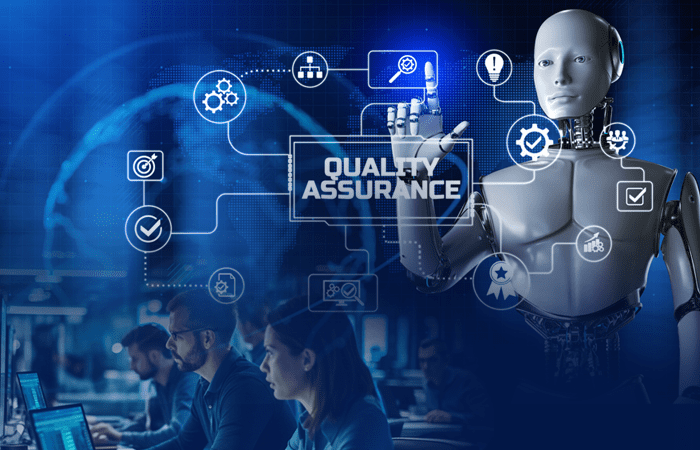
Leveraging RPA for Quality Assurance in Engineering Projects
Today, engineering firms are constantly seeking ways to improve efficiency, reduce costs, and deliver high-quality products and services. One of the key areas where these improvements can be made is in quality assurance (QA). Traditionally, QA in engineering projects has been a labor-intensive process, requiring significant time and resources to ensure that every aspect of a project meets the required standards.
However, with the advent of Robotic Process Automation (RPA), the QA process is undergoing a transformation. By automating repetitive and time-consuming tasks, RPA is helping engineering firms enhance the accuracy, speed, and consistency of their QA processes.
This blog explores how RPA can be leveraged for quality assurance in engineering projects and how partnering with an engineering specialist firm can further optimize these processes.
Understanding Robotic Process Automation (RPA)
Robotic Process Automation (RPA) is a technology that uses software robots, or “bots,” to automate repetitive, rule-based tasks traditionally performed by humans. These bots can interact with various applications, systems, and databases, executing tasks such as data entry, calculations, and report generation with high precision and speed.
In the context of engineering projects, RPA can be used to automate numerous QA tasks, from document verification to test case execution, enabling teams to focus on more complex and value-added activities.
The Role of Quality Assurance in Engineering Projects
Quality assurance is a critical component of any engineering project. It involves a series of systematic processes and checks to ensure that the final product or service meets the specified requirements and standards. QA encompasses various stages of the engineering lifecycle, including design, development, testing, and maintenance. The primary goals of QA in engineering projects are to:
Ensure Compliance: Engineering projects must adhere to industry standards, regulatory requirements, and client specifications. QA processes help ensure that these requirements are met.
Minimize Defects: QA aims to identify and correct defects in the early stages of a project, reducing the likelihood of costly rework or project delays.
Enhance Customer Satisfaction: By delivering high-quality products and services, engineering firms can improve customer satisfaction and build long-term relationships with clients.
Optimize Resource Utilization: Efficient QA processes help engineering firms utilize their resources more effectively, reducing waste and improving overall project outcomes.
How RPA Enhances Quality Assurance in Engineering Projects?
RPA offers several advantages that can significantly enhance QA processes in engineering projects. Here are some key ways RPA can be leveraged for QA:
- Automating Repetitive Tasks
One of the most significant benefits of RPA is its ability to automate repetitive and time-consuming tasks. In QA, this includes tasks such as data entry, document verification, and test case execution.
By automating these tasks, RPA reduces the risk of human error, ensures consistency, and frees up valuable time for QA teams to focus on more complex activities. For example, instead of manually checking thousands of lines of code for errors, an RPA bot can quickly and accurately perform this task, allowing engineers to spend more time on design and development.
- Enhancing Data Accuracy and Consistency
In engineering projects, accuracy is paramount. Even a small error in data can lead to significant issues down the line, from design flaws to product defects. RPA bots can be programmed to handle large volumes of data with high precision, ensuring that the information used in QA processes is accurate and consistent.
This is particularly important in industries such as aerospace, automotive, and construction, where even minor deviations from specifications can have serious consequences.
- Accelerating the QA Process
Time is often a critical factor in engineering projects, with tight deadlines and schedules to meet. RPA can significantly accelerate the QA process by performing tasks faster than humans ever could. For instance, an RPA bot can execute thousands of test cases in a fraction of the time it would take a human team to do so.
This speed not only helps engineering firms meet project deadlines but also allows them to iterate and improve their designs more quickly.
- Enabling Continuous Testing and Monitoring
Continuous testing and monitoring are essential components of modern QA processes, particularly in complex engineering projects. RPA can be used to set up automated testing frameworks that run continuously throughout the project lifecycle.
This allows for real-time detection of issues and defects, enabling teams to address problems as soon as they arise. Continuous testing also supports the agile development methodology, where iterative testing and feedback are crucial for delivering high-quality products.
- Improving Compliance and Reporting
Compliance with industry standards and regulations is a critical aspect of QA in engineering projects. RPA can help ensure compliance by automating the collection, analysis, and reporting of data related to regulatory requirements. For example, an RPA bot can automatically generate compliance reports based on the latest project data, reducing the risk of non-compliance and minimizing the need for manual intervention.
This not only saves time but also ensures that the project remains on track and meets all necessary legal and regulatory requirements.
- Reducing Costs and Increasing ROI
By automating QA processes, RPA can help engineering firms reduce labor costs and increase return on investment (ROI). The cost savings come from reduced manual labor, fewer errors and defects, and faster project completion times. Additionally, the ability to detect and correct issues early in the project lifecycle leads to lower rework costs and higher overall project quality. Over time, these savings can have a significant impact on the firm’s bottom line.
How an Engineering Specialist Firm Can Help You?
While RPA offers numerous benefits for QA in engineering projects, implementing and managing RPA solutions can be complex. This is where an engineering specialist firm can provide valuable assistance. Engineering firms with expertise in RPA can help you:
- Assess Your QA Processes: A specialist firm can conduct a thorough assessment of your existing QA processes to identify areas where RPA can be most effectively applied. This ensures that your RPA implementation is targeted and delivers maximum value.
- Develop Customized RPA Solutions: Engineering specialist firms can develop customized RPA solutions tailored to your specific project needs. Whether it’s automating document verification or setting up continuous testing frameworks, these firms have the expertise to create solutions that align with your goals.
- Ensure Seamless Integration: Integrating RPA into your existing systems and workflows can be challenging. An engineering specialist firm can ensure seamless integration, minimizing disruption to your operations and ensuring that your RPA solutions work harmoniously with your other tools and technologies.
- Provide Ongoing Support and Optimization: The journey doesn’t end with the initial implementation of RPA. Engineering specialist firms can provide ongoing support and optimization to ensure that your RPA solutions continue to deliver value over time. This includes monitoring performance, making necessary adjustments, and updating bots as needed to keep pace with changing project requirements.
- Enhance Compliance and Reporting: Engineering specialist firms can help you leverage RPA to improve compliance and reporting processes, ensuring that your projects meet all necessary standards and regulations. They can also assist with automating the generation of compliance reports, reducing the administrative burden on your team.
Robotic Process Automation is transforming the way quality assurance is conducted in engineering projects. By automating repetitive tasks, enhancing data accuracy, accelerating processes, and improving compliance, RPA is helping engineering firms deliver higher-quality products and services more efficiently.
However, to fully realize the benefits of RPA, it’s essential to partner with an engineering specialist firm that can guide you through the implementation process and provide ongoing support. With the right expertise and tools, RPA can become a powerful asset in your QA arsenal, driving better project outcomes and ensuring long-term success.
The Industrial Internet of Things (IIoT) is transforming the industrial landscape by connecting machines, sensors, and devices, enabling real-time data collection and analysis. This connectivity brings unprecedented efficiency, productivity, and innovation opportunities. However, it also introduces significant cybersecurity risks. As industrial systems become increasingly interconnected, they become more vulnerable to cyber threats, making the security of IIoT systems paramount.
In this blog, we will explore the importance of securing IIoT systems and provide strategies to mitigate cyber threats, addressing the concerns of clients worried about data breaches and security risks.
The Importance of Securing IIoT Systems
- Protecting Critical Infrastructure
IIoT systems are often integrated into critical infrastructure, such as power grids, water treatment facilities, and transportation systems. A cyber attack on these systems can have catastrophic consequences, leading to service disruptions, safety hazards, and economic losses. Ensuring the security of IIoT systems is essential to protect public safety and maintain the continuity of essential services.
- Safeguarding Sensitive Data
IIoT systems collect vast amounts of data, including operational information, production metrics, and even employee and customer data. This data is valuable to cybercriminals who can exploit it for financial gain or industrial espionage. Securing IIoT systems helps protect sensitive data from unauthorized access and theft.
- Maintaining Operational Continuity
Cyber attacks can disrupt industrial operations, leading to downtime and productivity losses. For instance, a ransomware attack can lock down critical systems, forcing companies to halt production until the issue is resolved. By securing IIoT systems, companies can minimize the risk of operational disruptions and ensure business continuity.
- Compliance with Regulations
Many industries are subject to strict regulations regarding data protection and cybersecurity. Non-compliance can result in hefty fines, legal penalties, and reputational damage. Implementing robust IIoT security measures helps companies comply with regulatory requirements and avoid potential legal and financial repercussions.
Strategies to Mitigate Cyber Threats in IIoT Systems
- Implementing Strong Authentication and Access Controls
One of the most effective ways to secure IIoT systems is by implementing strong authentication and access controls. This includes using multi-factor authentication (MFA) to verify user identities and restricting access to sensitive systems and data based on the principle of least privilege. Role-based access control (RBAC) can help ensure that users only have access to the resources they need for their specific roles.
- Encrypting Data at Rest and in Transit
Data encryption is crucial for protecting sensitive information from unauthorized access and tampering. Encrypting data at rest ensures that even if an attacker gains physical access to storage devices, they cannot read the data without the encryption key. Encrypting data in transit protects it from interception and eavesdropping as it moves between devices and systems. Implementing end-to-end encryption ensures that data remains secure throughout its lifecycle.
- Regularly Updating and Patching Systems
Keeping IIoT devices and systems up to date with the latest software patches and security updates is essential for protecting against known vulnerabilities. Cybercriminals often exploit unpatched vulnerabilities to gain access to systems and networks. Regularly updating and patching systems helps close these security gaps and reduces the risk of exploitation.
- Segmenting Networks
Network segmentation involves dividing a network into smaller, isolated segments to limit the spread of cyber threats. By segmenting IIoT networks, companies can contain the impact of a potential breach and prevent attackers from moving laterally across the network. Implementing firewalls, virtual local area networks (VLANs), and intrusion detection systems (IDS) can help enforce network segmentation and enhance security.
- Monitoring and Analyzing Network Traffic
Continuous monitoring and analysis of network traffic can help detect and respond to cyber threats in real time. Implementing intrusion detection and prevention systems (IDPS) can alert security teams to suspicious activity and block malicious traffic.
Advanced threat detection tools, such as Security Information and Event Management (SIEM) systems, can provide comprehensive visibility into network activity and facilitate rapid incident response.
- Implementing Robust Endpoint Security
IIoT devices often have limited security features, making them attractive targets for cybercriminals. Implementing robust endpoint security measures, such as anti-malware software, intrusion prevention systems, and device management solutions, can help protect IIoT devices from cyber threats. Regularly updating firmware and applying security patches is also essential for maintaining the security of IIoT endpoints.
- Conducting Regular Security Assessments and Penetration Testing
Regular security assessments and penetration testing can help identify vulnerabilities in IIoT systems before cybercriminals can exploit them. Conducting these assessments allows companies to proactively address security weaknesses and strengthen their defenses. Engaging third-party security experts to perform penetration testing can provide an unbiased evaluation of the security posture and identify potential areas for improvement.
- Implementing Security Policies and Employee Training
Establishing comprehensive security policies and procedures is essential for guiding the organization’s approach to IIoT security. These policies should cover aspects such as access control, data protection, incident response, and employee responsibilities. Additionally, providing regular cybersecurity training to employees helps raise awareness about cyber threats and promotes best practices for maintaining security. Employees should be educated on how to recognize phishing attempts, secure their devices, and report suspicious activities.
As IIoT systems continue to revolutionize industrial operations, securing these systems against cyber threats becomes increasingly critical. The potential consequences of a cyber attack on IIoT systems, including service disruptions, data breaches, and operational downtime, underscore the importance of robust cybersecurity measures.
By implementing strong authentication and access controls, encrypting data, regularly updating systems, segmenting networks, monitoring network traffic, securing endpoints, conducting security assessments, and fostering a security-aware culture, companies can effectively mitigate cyber threats and protect their industrial assets in a connected world.
Securing IIoT systems is not just a technical challenge; it is a strategic imperative that requires ongoing vigilance and commitment. By prioritizing cybersecurity and adopting a proactive approach, companies can harness the full potential of IIoT while safeguarding their critical infrastructure, sensitive data, and operational continuity. In an era where cyber threats are constantly evolving, a comprehensive and adaptive IIoT security strategy is essential for ensuring a resilient and secure industrial environment.


